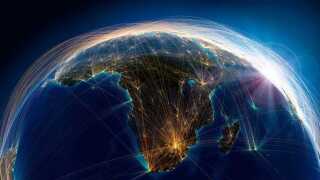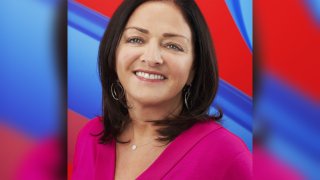The long-running controversy over whether too much essential intercontinental capacity relies on the vulnerable chokepoints of the Red Sea, the Suez Canal and the Mediterranean coast of the troubled state of Egypt shows no sign of subsiding.
Calls for credible alternatives that avoid Egypt altogether have been heard again, following a sequence of mishaps in the early part of 2013. Over a short period, man-made damage affected services on several systems, including the IMEWE, SEA-ME-WE 3, Europe India Gateway and TE North cables. This run of bad luck was topped off when the Egyptian navy arrested three scuba divers off the port of Alexandria as they were cutting through SEA-ME-WE 4, another Asia-to-Europe artery.
The exact motivation of the divers remains unclear, but their intent appears criminal. It can be surmised that they were hitting out at Egypt’s government – headed at that time by President Mohamed Morsi, whose Muslim Brotherhood party was elected in 2012.
Providing one third of the capacity between Egypt and Europe, SEA-ME-WE 4 is an obvious target for the politically disaffected. Morsi’s regime has subsequently been ousted by Egypt’s military and all broken infrastructure restored, but a lingering sense of vulnerability and fragility still envelopes the region.
It is by no means the first time that unexpected problems have afflicted essential cables in this zone, as Faisal Ghaus, VP of the TechNavio Research consultancy, points out.
“One of the major challenges on the Egypt route has always been hazards arising from man-made fibre cuts,” he suggests. “In the period from 2007 to 2012, almost 90% of fibre cuts on that route were due to the fishing and anchoring of fishing boats, ships and other human activity, in water depths of less than 200m.”
Alternative connections
As things stand, Egypt cannot in any practical sense be cut out of the equation. Insufficient alternative capacity exists that traverses the Middle East without negotiating the Red Sea. Diversity is starting to emerge, however, with more than one terrestrial solution either in the early stages of service or in advanced planning.
The latest plan to be unveiled is the Middle East-Europe Terrestrial System (MEETS). Backed by a consortium of regional operators – UAE operator du, Vodafone Qatar, and Kuwaiti firms Zajil and Zain Group – it would connect several Gulf states and pass on to Turkey.
Phase one of its construction is scheduled to start in early 2014, terrestrially linking the UAE, Qatar, Bahrain, and Kuwait, using the Gulf Cooperation Council Interconnection Authority’s regional power grid as a conduit. A second phase would run from Kuwait to Turkey via Iraq. A subsequent European leg is then envisaged.
Two other terrestrial systems are on standby. Both Jeddah Amman Damascus Istanbul (JADI) and the Regional Cable Network (RCN) have been more or less completed, but have yet to be lit, pending the cessation of violence in Syria.
There are also working terrestrial systems, as well as planned ones. The Europe-Persia Express Gateway (EPEG) was launched in January 2013, linking Germany to Oman on a route that takes in Russia, Azerbaijan and Iran. Shortly after EPEG entered service, cable operator Gulf Bridge International introduced GBI-North, a terrestrial network that connects the company’s Iraqi PoP to Turkey.
Türk Telekom International and Palestine Telecom have also launched a hybrid system that brings together subsea capacity on the MedNautilus cable with terrestrial bandwidth on Palestine Telecom’s network, going as far as the Jordanian border.
Dire straits
But none of these solutions is free of drawbacks, or some element of difficulty or controversy. EPEG, for example, uses the Strait of Hormuz, which almost rivals the Red Sea as the region’s trickiest bottleneck. Its launch was delayed again and again by one or other bit of regional tension between the players along its considerable length, suggesting that its future use may also be problematic.
Julian Rawle, managing partner with subsea engineering firm Pioneer Consulting, believes all terrestrial Middle East solutions involve compromise.
“The way Egypt has played out has forced people to look at new routes,” he believes. “Some of the new cables in the region would simply not be where they are if it were possible to lay a cable straightforwardly through the Suez Canal without any interference.”
Rawle believes furthermore that it is “nonsense” to regard terrestrial alternatives to Suez as inherently less vulnerable. He nevertheless expects more of them to be built, as people continue to look for a wider portfolio of options.
While some fret about political tensions that could endanger terrestrial fibre, Leigh Frame, COO with Alcatel-Lucent Submarine Networks, sees geographic challenges.
“Deserts are not ideal places to lay cables that you need to stay in service,” he says. “Luckily, Telecom Egypt has got lots of experience on the submarine side, and is serving the world well.”
Mohamed El-Nawawy, Telecom Egypt’s CEO, confirms that his company is actively looking at ways to enhance the security of the various subsea cables that land on the country’s shores, and urges the global carrier community to keep faith with them.
“Egypt has 1,000km of Mediterranean coast and 1,000km of Red Sea coast,” he points out. “What we need is more diversity of landings on that long coast, and that’s what we are planning. We’re looking, for example, at deep water 30km to the west of Alexandria.”
El-Nawawy is not entirely dismissive of terrestrial alternatives, believing that any additional capacity can only complement what already exists. But like Rawle, he fears that there is no easy, trouble-free way across the Middle East by land.
“Looking at the terrestrial alternatives that exist at the moment, they all cross multiple jurisdictions and I wonder if this is ideal,” he says. “The sea, on the other hand, has no borders, and is common to all mankind.”
United we stand
Another enhancement that Telecom Egypt is trying to encourage among all the region’s stakeholders is better interconnection of existing subsea systems.
“We have enough cables for the time being in the region, and now it’s time to mesh them more effectively,” he claims. “At one point, the Atlantic was all about individual unmeshed systems, but not anymore. Cables get cut there too, but with no loss of overall service, so it doesn’t make the news. Our coastline can be the same.”
Better meshing equals happier cable customers, agrees Vivek Jhamb, SVP, northern Europe and North America region with Vodafone Carrier Services.
“The success and resilience of any subsea cable system is dependent upon the business continuity standards in place to support it,” he believes. “We ensure we have very resilient international connectivity by investing in meshed network technology with significant route diversity. A good example of the resultant robustness of our network was demonstrated during the Japanese earthquake and tsunami two years ago. Not a single mesh-protected customer lost service, despite the high number of cable breaks in the region.”
Ali Amiri, EVP of Etisalat’s carrier and wholesale services, also sets high store by safety through diversity, and for that reason is unhappy about any choice as stark as “Egypt or no Egypt”. He instead favours a menu of submarine and land routes as healthiest for all parties.
“We’ve got a stake in RCN planned and ready to go, low latency from UAE to Turkey,” he adds. “This will complement our subsea investments, once the trouble in Syria is over. I would expect RCN to be able to go live within a month of any peace settlement, adding to the options on offer.”
Amiri thinks Egypt gets a bad rap.
“Repair times on damaged cables have not been too long, less than 24 hours in some cases,” he says.
The Middle East is an entirely different telecommunications prospect now, compared to just five years ago. Its fibre diversity is growing richer, and local traffic volumes are starting to grow and add to capacity utilisation. But it would be a shame if it were to keep hitting the headlines for the wrong reasons.




